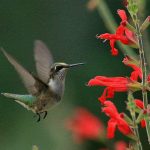Wildscape 101
Welcome wildlife to your yard and reclaim habitat lost to urbanization.

Backyard Habitats
Welcome wildlife to your yard and reclaim habitat lost to urbanization. Songbirds, butterflies, bees and other pollinators will benefit from a community connected through backyard habitats. Include food, water, shelter, and other basics, then enjoy watching the wildlife!
Attract wildlife with the plants they know best – native plants! Native plants and wildlife evolved together, so animals will easily recognize these familiar sources of food and shelter. Some nonnative, adapted plants also provide benefits, but make sure they are not invasive before you plant them.
Elements of a Wildscape
- Food –Provide food sources in all seasons by including a variety of plants that provide nectar, pollen, leaves, nuts, berries and seeds. Plant diversity is key to attracting more animals.
- Water – Provide a clean, reliable source of water, such as a bird bath or small pond.
- Shelter – Give cover for wildlife to hide, rest and nest in your garden. Dense plantings make animals feel safer, so clump plants together. Create corridors of dense plants for them to move about safely.
- Design Tip – Plant layers allow more species to live in the same area. Create vertical layers with flowers, grasses, shrubs and trees. Leave fallen branches and keep snags for habitat when it is safe to do so.
- Minimize Lawns – Lawns provide less food than other areas and expose animals to predators. Save on watering thirsty turf and instead expand your flowers beds and add more trees and shrubs to your property.
GARDEN SUSTAINABLY
Sustainable garden practices are good for wildlife and human communities alike. Minimize your water use and try compost instead of inorganic fertilizers. Many animals rely on insect populations so avoid using chemical pesticides. Remove invasive nonnative plants to prevent them from spreading to nearby natural ecosystems.
MORE TIPS
- Leave some areas of your yard natural and avoid disturbing the leaf litter.
- Let wildflowers go to seed and leave them as a food source.
- Use a soaker hose or water by hand. Don’t water plants from above and wash away nectar and pollen.
- Keep your edges neat to blend into more traditional neighborhood landscapes.
Related Video

Related Article





